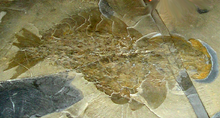Anomalocaris canadensis
|
Anomalocaris Temporal range: Early to mid Cambrian: Chengjiang–Burgess shale |
|
|---|---|
 |
|
| Image of the first complete Anomalocaris fossil found, residing in the Royal Ontario Museum | |
| Scientific classification | |
| Kingdom: | Animalia |
| Class: | †Dinocaridida |
| Order: | †Radiodonta |
| Family: | †Anomalocarididae |
| Genus: |
†Anomalocaris Whiteaves 1892 |
| Species | |
|
|
| Synonyms | |
|
Defunct species:
|
|
Defunct species:
Anomalocaris ("abnormal shrimp") is an extinct genus of anomalocaridid, a family of animals thought to be closely related to ancestral arthropods. The first fossils of Anomalocaris were discovered in the Ogygopsis Shale by Joseph Frederick Whiteaves, with more examples found by Charles Doolittle Walcott in the famed Burgess Shale. Originally several fossilized parts discovered separately (the mouth, feeding appendages and tail) were thought to be three separate creatures, a misapprehension corrected by Harry B. Whittington and Derek Briggs in a 1985 journal article.
Anomalocaris is thought to have been a predator. It propelled itself through the water by undulating the flexible lobes on the sides of its body. Each lobe sloped below the one more posterior to it, and this overlapping allowed the lobes on each side of the body to act as a single "fin", maximizing the swimming efficiency. The construction of a remote-controlled model showed this mode of swimming to be intrinsically stable, implying that Anomalocaris would not have needed a complex brain to manage balance while swimming. The body was widest between the third and fifth lobe and narrowed towards the tail; it had at least 11 lobes in total. It is difficult to distinguish lobes near the tail, making an accurate count difficult.
Anomalocaris had a large head, a single pair of large, compound eyes on stalks comprising approximately 16,000 lenses, and an unusual disk-like mouth. The mouth was composed of 32 overlapping plates, four large and 28 small, resembling a pineapple ring with the center replaced by a series of serrated prongs. The mouth could constrict to crush prey, but never completely close, and the tooth-like prongs continued down the walls of the gullet. Two large 'arms' (up to 18 centimeters in length when extended) with barb-like spikes were in front of the mouth. The tail was large and fan-shaped, and along with undulations of the lobes, was probably used to propel the creature through Cambrian waters. Stacked lamella of what were probably gills attached to the top of each lobe.
...
Wikipedia
